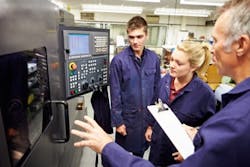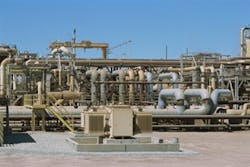Machine learning has been researched for decades, but its use in applying artificial intelligence in industrial plants and asset operations and maintenance is now advancing exponentially. This is due to the growth in Big Data, the expansion of the internet of things (IoT), the ability to provide the processing power needed to analyze larger data sets, the availability of machine-learning methods, and the need for superior predictive and prescriptive capabilities required to manage today’s complex assets.
While machine learning has typically been linked with industries such as transportation and banking (think self-driving cars and fraud monitoring, respectively), there are many uses for machine learning within the industrial sector. We’ll focus here on some of the principles within machine learning and on industries that are primed to take advantage of the application of machine learning to maximize the benefits it can bring to improve situational intelligence, performance, and reliability.
The route to deeper understanding
Machine learning makes complex processes and data easier to understand and is ideal for industries that are asset- and data-rich. A great deal of data from various data sources is required in machine learning, and a data scientist or analyst may be needed to help set up and interpret the results. While it is possible to build your own ML platform, this design takes time, specific skills, and investment in a tool such as Microsoft Azure for a secure, private cloud platform for developers and data scientists. Alternatively, purchasing machine-learning capabilities off the shelf as part of an asset performance management software solution or outsourcing ML to a third party are options, provided you ensure that you can supply input from in-house skills.
Supervised machine learning
Supervised learning is the most common technique. There are many steps involved – uploading data sets, training the data, choosing the algorithms, visualizing the data, and more – to lead you to finish with the desired level of accuracy that can then be applied to new data to start the predictive stage. Supervised learning encompasses two techniques:
The implications for machine learning in the manufacturing space include reductions in operating costs, improved asset reliability, and increased productivity — three goals that are the holy trinity of manufacturing.
Classification: Classification is typically used for data that can be categorized – for instance, in determining whether an email can be classified as worthwhile or spam. Common algorithms used within classification techniques include logistic regression, decision-tree, and neural networks.
Predictive maintenance falls into the classification approach because it has several possible outcomes that can be categorized as potential equipment problems generated by various parameters, such as levels of risk, health indices, reasons for failure, etc.
This is the same way machine learning is used to predict a medical diagnosis: by identifying symptoms and issuing a diagnosis. Predictive maintenance has a multiclass classification because there are multiple categories or reasons why a piece of equipment will fail, whereas with the email example, there are only two binary states, genuine or spam.
Regression: Regression is used when data has a range, such as with sensor or device-driven data, and it is used to estimate or predict a response from one or more continuous values. The most common algorithm for regression is linear regression. This is one of the most easily applied algorithms because it is easy to interpret and quick to implement. Measuring and predicting a temperature is an example of linear regression because it has a continuous value where the estimate would be easy to train.
Unsupervised learning
Clustering: While supervised learning usually has an expected outcome to work from and can be trained, unsupervised learning is usually applied when the specific goal is not yet known or the information of the data is unknown. This means that the data is grouped or clustered together and then meanings are deduced from patterns hidden in the input data by putting the data into similar groups.
Neural networks: A neural network, which can be both supervised and unsupervised, is one group of algorithms used for machine learning that models the data using graphs of artificial neurons (i.e., neurons that are a mathematical model that simulate approximately how a neuron in the brain operates). For instance, if a brain were a city, neural networks would be the transportation routes, or networks, within it.
Whatever path is chosen, the benefits that machine learning can bring to Big Data are only just coming to fruition. Here are four industries at the forefront, leading the way in this fast-moving digital transformation.
Electrical supply: Making the grid smarter
We all are familiar with the term “smart grid” – the electrical supply network that uses digital technology and measures to detect and react to usage issues. What can machine learning bring to a grid that is already smart? Quite a lot, it seems.
Predictive maintenance, common throughout all asset-intensive industries mentioned here, is again top of the list in any industry, especially in utilities, where an enormous number of connected assets are spread across a large network. Given the presence of transformers, pylons, cables, turbines, storage units and more, the potential for equipment failure is high and not without risk, so predicting failures with data and models is one answer to keep the network running smoothly. Another example of how machine learning helps the utilities industry is found in demand forecasting, where predicting use and consumption from numerous parameters can help a utility better balance supply with anticipated demand levels.
Safe, reliable, predictable production in oil and gas
With environmental, safety, and business stakes high, prediction and early identification of equipment failures is one of the most important applications of machine learning in the oil and gas industry.
In the oil and gas industry, the ability to recognize equipment failure, avoid unplanned downtime and repair costs, and prevent potential environmental damage is critical to success across all areas of the business, from well reservoir identification to production and processing. In terms of maintaining safe, reliable, and predictable production, identifying equipment failures is one of the main areas in which machine learning will play an important role. Predictive maintenance is the failure inspection strategy that uses data and models to predict when an asset or piece of equipment will fail so that maintenance can be planned well ahead of time to minimize disruption.
Save time and reduce costs in water utilities
Water utilities also face the challenges of an aging infrastructure, rising costs, tighter regulations, and increasing demand. With that, they also share the same benefits that machine learning offers, such as identification of imminent equipment failure before a failure occurs—to not just predict a failure, but to determine what type of failure it will be.
Water distribution can be optimized with the application of artificial intelligence. Machine learning can be used in this scenario to accelerate decision-making about how to meet water demand through analysis of supply needs from various locations (reservoirs, desalination plants, and rivers), as well as pumping considerations and water movement. Associated costs and restraints also are taken into account.
Smart manufacturing
Richard Irwin is a senior product marketer for Bentley System’s AssetWise Operational Analytics service and has more than 10 years’ experience in the analytics industry. Irwin works with the sales and industry teams to coordinate marketing opportunities across a wide variety of industries applicable to AssetWise. Based in the United Kingdom, he holds a master’s degree in sociology from Aberdeen University and a master’s in IT from Heriot Watt, Edinburgh.
Manufacturing generally is one step ahead of most other industries with the application of automation; witness the still-rising use of robots to perform repetitive tasks that once were managed by humans on the production line. Today’s industrial robots, in this stage of early artificial intelligence, can already outperform a person in their given tasks through a combination of training and repetition. They can also carry out this task day in, day out, without the need for breaks, sleep, wages, or health insurance.
Manufacturing has always been the main industry when mentioning machine learning, and for good reason, as the benefits are very real. These benefits include reductions in operating costs, improved asset reliability, and increased productivity — three goals that are the holy trinity of manufacturing. To achieve this, manufacturing also requires a digital platform to capture, store, and analyze data generated by control systems and sensors on equipment connected via the IoT.
Digitalization and transformation with machine learning
These are just some of the sectors that will be early adopters of machine learning. Some are already reaping benefits in the form of faster information delivery and reduced costs. As the technology advances, industries will learn from each other, further advancing the use and influence of artificial intelligence. Having a machine-learning strategy in place will give you unprecedented insight into your operation and will lead to benefits in efficiency, safety, optimization, and decision-making. The digital transformation for industry is now at a tipping point, with technologies converging at the same time. Wide-ranging problems that once took months to address now are being resolved in a matter of minutes thanks to machine learning.



